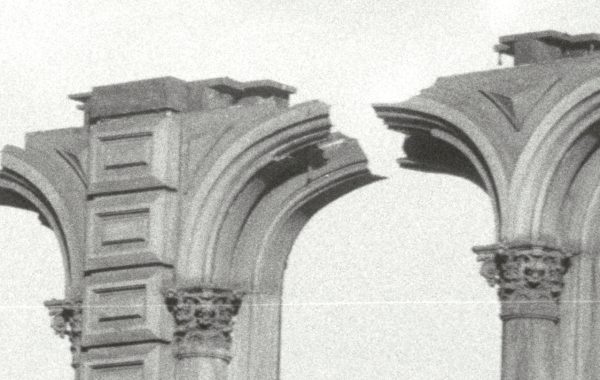A little more historical research, although it’s very easy when someone else has already done the hard work.
Click to enlarge:
That’s the front step of a loft building downtown. The step is made of the same kind of cast-iron plate with glass inserts used for vault lights – and indeed, originally used at this building for the adjacent portion of vault roof until it was removed in the 1950s – and has the foundry’s name cast into it. Specifically, “G. R. JACKSON, BURNET & Co. 201 CENTRE St. N.Y.”
There’s a famous Jackson in New York iron-working history: James L. Jackson. The Jackson Architectural Iron Works started in cast iron and later moved into wrought iron and steel, and ended up working on a number of prominent buildings late in the nineteenth century. That’s not who cast the front step, however: people who I haven’t lulled to sleep might notice that James L. Jackson’s initials are not “G.R.”
As I mentioned above, I didn’t have to search very far to find this Jackson (and the semi-forgotten Burnet): The company and its predecessors and successors – Cornell & Jackson; the George R. Jackson Iron Works; George R. Jackson, Burnet & Co.; Burnet, Jackson & Co.; and the Excelsior Iron Works – are described in detail here. One of the more bizarre points is that the George Cornell, a partner in the earliest version of the company, is the older brother of John and William Cornell, who ran the famous J. B. & W. W. Cornell iron works.
The description of these and similar firms makes it clear that these were family businesses – sons joining their father’s firms, sometimes splitting off – and that the partnerships were often unstable, with men going from one company to another and companies merging, breaking up, and re-forming. To some degree that is simply the world of business, but I have to wonder how much of the churn was caused by the nature of their business. Cast iron in the mid-1800s was a high-tech industry for the United States. There were plenty of trade secrets, highly-skilled workers, and a rapidly expanding market, just like we’ve seen in every new high-tech industry since. Tom Carroll describes Troy, New York, as the “Silicon Valley of the Nineteenth Century” specifically because the social aspects of high tech industries are so similar from one era to the next. (I should also mention here that Tom is the person who got me interested in the history of technology, when I was his student at RPI.) There is a comparison to be made, for example, between the 1840s-1860s cast-iron scene in New York and the 1980s-90s personal computer scene (mostly in the San Fransisco Bay area, but elsewhere as well), in the churn of people and companies, in the eventual transformative effects on society as a whole, and in the incomprehensibility of the inside story to outsiders.
That’s a lot to spin off a cast-iron step, but the history of technology can only be understood at all by starting with its connectedness.




You must be logged in to post a comment.